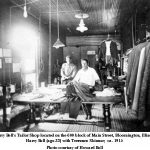This post was co-written by Ben Ostermeier, developer for Madison Historical.
The IDHH thanks Madison Historical, a collaboration of Southern Illinois University, Edwardsville, and 26 local Madison County institutions, for sharing their collections with the DPLA. Madison County, home to Edwardsville, Granite City, Alton, and Madison, was the place of residence of abolitionist, Elijah Lovejoy, whose murder by pro-slavery sympathizers in 1837 inspired anti-slavery activists and militants, including John Brown. Historically, Madison county was a much larger and once occupied land from Michigan’s Upper Peninsula, parts of Minnesota, Wisconsin, and the northern two thirds of Illinois.
Madison County is well known as a seat of industry in the state of Illinois. One of the oldest and longest enduring is agriculture, including wheat, corn, soy, and horseradish. Pictured below are some early tractors from the turn of the 20th century, often assisted by horses.
Madison County was also home to the Illinois Glass Company, based in Alton. The company merged with the Owens Bottle Machine Company in 1923 to become the Owens-Illinois Glass Company and the largest glass bottle producer in the world. Their largest factory was in Alton until it closed in 1983.
Coal mining was another leading industry through the mid-20th century, though mines are now abandoned. Below are pictures of the people and equipment that made Madison County one of the leading coal-producing regions in the country.
A major industry still active in Madison County is oil refining, with John D. Rockefeller’s Standard Oil establishing a refinery in 1908 in Wood River, and Shell Oil establishing another in Roxana in 1918. The Shell Oil refinery is now operated by Phillips 66.
Finally, the railroad industry played a huge role in the development of Madison County, tying into both agriculture, mining, as well as petroleum. Trains made commerce across Illinois and throughout the country more efficient, transporting Madison County’s products throughout the U.S.
Another collection belonging to Madison Historical are a series of high school newspapers from Granite City High School from the 1930s to the 1950s. Spanning the Great Depression, World War II, and the early years of the Cold War, the newspapers offer fascinating insight into adolescent reactions to major world events of the 20th century.

See all of the Madison Historical Items in the DPLA.
See other items contributed by Southern Illinois Edwardsville.




















